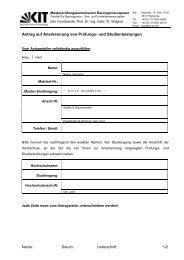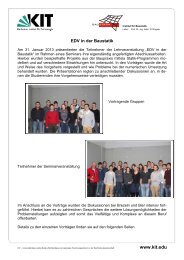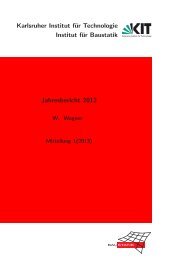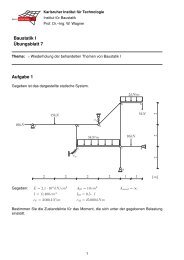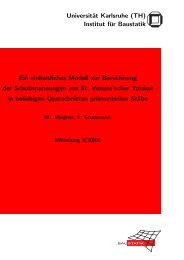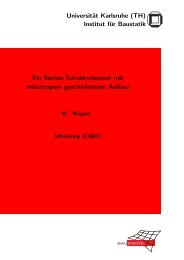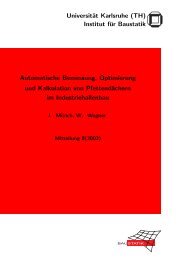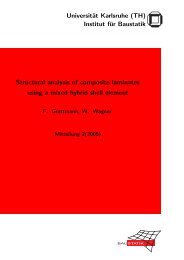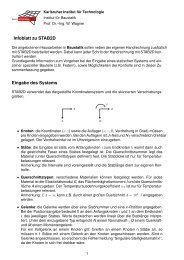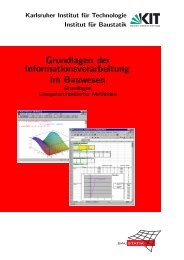Universität Karlsruhe (TH) - am Institut für Baustatik
Universität Karlsruhe (TH) - am Institut für Baustatik
Universität Karlsruhe (TH) - am Institut für Baustatik
Create successful ePaper yourself
Turn your PDF publications into a flip-book with our unique Google optimized e-Paper software.
as close as possible to the coordinates ξ and η. Hence the Jacobian matrix J is defined<br />
with<br />
⎡<br />
J = ⎣ Xh , ξ ·t 1 X h ⎤<br />
, ξ ·t 2<br />
⎦ (14)<br />
X h , η ·t 1 X h , η ·t 2<br />
X h , ξ = G 0 ξ + η G 1 G 0 ξ = 1 4∑<br />
ξ I X I<br />
4<br />
I=1<br />
X h , η = G 0 η + ξ G 1 G 0 η = 1 4∑<br />
η I X I<br />
4<br />
I=1<br />
G 1 = 1 4∑<br />
ξ I η I X I .<br />
4<br />
I=1<br />
One can prove that t 3 · G 0 ξ =0andt 3 · G 0 η = 0 holds which shows that t 3 is normal vector at<br />
the element center. Thus t 1 and t 2 span a tangent plane at the center of the element. Now<br />
we are able to express the local cartesian derivatives of the shape functions using the inverse<br />
Jacobian matrix J. The tangent vectors X, α and the derivatives of the director vector D, α<br />
are computed considering (12) as follows<br />
X h , α =<br />
4∑<br />
I=1<br />
N I , α X I D h , α =<br />
4∑<br />
I=1<br />
(15)<br />
[ ] [ ]<br />
NI ,<br />
N I , α D 1<br />
I = J −1 NI , ξ<br />
. (16)<br />
N I , 2 N I , η<br />
For arbitrary warped elements one obtains X h , α = t α at the element center, which can be<br />
shown using above orthogonality conditions. This is important in the context of the present<br />
mixed interpolation. Furthermore a local cartesian system is advantageous to verify complicated<br />
nonlinear constitutive equations. At other points of the element the vectors X h , α are<br />
only approximately orthogonal.<br />
The current shell middle surface is approximated in the s<strong>am</strong>e way<br />
x h =<br />
x h , α =<br />
4∑<br />
N I x I d h =<br />
I=1<br />
4∑<br />
N I , α x I d h , α =<br />
I=1<br />
4∑<br />
N I d I<br />
I=1<br />
4∑<br />
N I , α d I ,<br />
I=1<br />
(17)<br />
where x I = X I + u I describes the current nodal position vector and d I = a 3I is obtained<br />
by an orthogonal transformation a kI = R I A kI , k =1, 2, 3. The rotation tensor R I is a<br />
function of the par<strong>am</strong>eters organized in the vector ω I =[ω 1I ,ω 2I ,ω 3I ] T and is computed via<br />
Rodrigues’ formula<br />
R I = 1 + sin ω I<br />
ω I<br />
Ω I + 1 − cos ω I<br />
Ω 2<br />
ωI<br />
2 I Ω I =skewω I =<br />
⎡<br />
⎤<br />
0 −ω 3I ω 2I<br />
ω<br />
⎢ 3I 0 −ω 1I<br />
⎥<br />
⎣<br />
⎦<br />
−ω 2I ω 1I 0<br />
Representation (18) is singularity free for ω I = |ω I | < 2π which can always be fulfilled if after<br />
a certain number of load steps a multiplicative update of the total rotation tensor is applied.<br />
7<br />
(18)




